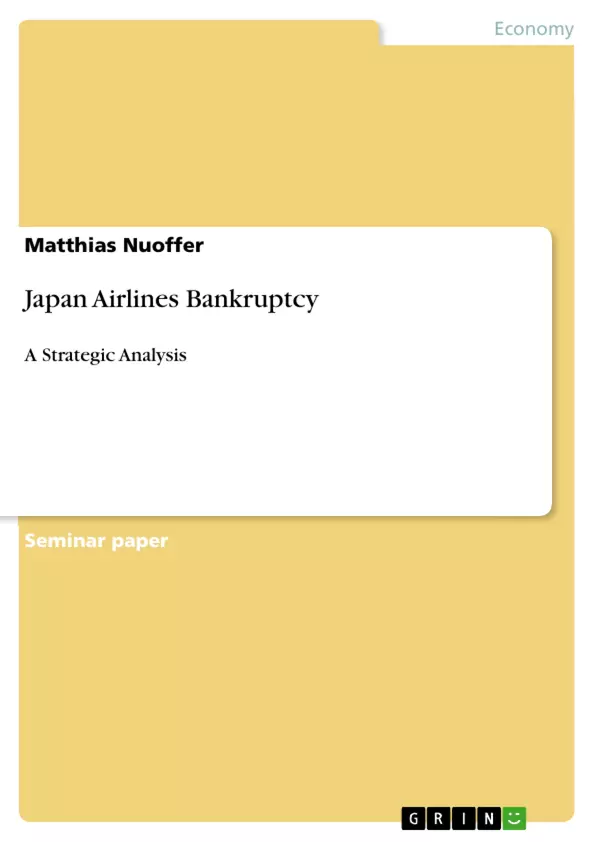On 19th January 2010, Japan Airlines (JAL), Asia's biggest carrier, filed for bankruptcy.
This assignment conducts both an external and internal analysis of JAL and gives a SWOT summary. From that, three strategic options are derived and discussed, leaving the most suitable, feasible and acceptable strategy. Finally, this strategy's potential implementation issues are debated.
Inhaltsverzeichnis (Table of Contents)
- 1. External Analysis
- 1.1 PESTEL
- 1.2 Porter's Five Forces
- 2. Internal Analysis
- 3. SWOT Summary
- 4. Key Strategic Issues
- 5. Strategic Options
- 6. Implementation Issues
Zielsetzung und Themenschwerpunkte (Objectives and Key Themes)
This strategic analysis aims to assess the situation of Japan Airlines (JAL) and identify key strategic issues contributing to its financial difficulties. The analysis utilizes external and internal analyses to understand the competitive landscape and JAL's internal performance.
- Competitive landscape of the airline industry
- JAL's financial performance and position relative to competitors
- Impact of macroeconomic factors on the airline industry
- Analysis of JAL's internal strengths and weaknesses
- Identification of strategic options for JAL's future
Zusammenfassung der Kapitel (Chapter Summaries)
1. External Analysis: This chapter provides an external analysis of the airline industry, focusing on both macro and micro environmental factors impacting JAL. The PESTEL analysis examines political, economic, social, technological, environmental, and legal factors influencing the industry, highlighting the impact of government regulations, economic growth in emerging markets, aging populations, technological advancements in online booking and fuel efficiency, and growing environmental concerns. Porter's Five Forces framework analyzes the competitive intensity within the airline industry, considering the threat of new entrants, supplier power, buyer power, threat of substitutes, and competitive rivalry. The analysis concludes that the airline industry is unattractive due to high competition, low margins, and various external constraints.
2. Internal Analysis: This chapter delves into JAL's internal performance, comparing its key financial figures and ratios with those of its main competitor, ANA. The analysis reveals JAL's significantly weaker financial position compared to ANA, characterized by losses, high debt, and low profitability. While JAL boasts a larger international route network than ANA, its profitability per route is drastically lower. This chapter highlights JAL's considerable financial challenges and operational inefficiencies, particularly in its international operations, as critical internal factors that need to be addressed.
Schlüsselwörter (Keywords)
Japan Airlines (JAL), Strategic Analysis, Airline Industry, PESTEL Analysis, Porter's Five Forces, Financial Performance, Competitive Rivalry, Macroeconomic Factors, Internal Analysis, Strategic Options.
Japan Airlines Strategic Analysis: Frequently Asked Questions
What is this document about?
This document is a comprehensive strategic analysis of Japan Airlines (JAL), focusing on its financial difficulties and exploring potential strategic options for its future. It includes an external analysis (PESTEL and Porter's Five Forces), an internal analysis comparing JAL to its main competitor ANA, a SWOT summary, key strategic issues, and potential implementation issues.
What are the key objectives of this analysis?
The main objective is to assess JAL's current situation, identify the key strategic issues contributing to its financial problems, and propose potential solutions. The analysis aims to understand the competitive landscape of the airline industry, JAL's financial performance relative to competitors, the impact of macroeconomic factors, JAL's internal strengths and weaknesses, and viable strategic options for the future.
What external factors are analyzed in this document?
The external analysis utilizes a PESTEL framework to examine political, economic, social, technological, environmental, and legal factors impacting the airline industry. It also employs Porter's Five Forces model to analyze competitive intensity, including the threat of new entrants, supplier and buyer power, the threat of substitutes, and competitive rivalry. The analysis concludes that the airline industry is characterized by high competition, low margins, and various external constraints.
What internal factors are analyzed?
The internal analysis focuses on JAL's financial performance, comparing its key financial figures and ratios with those of its competitor, ANA. It reveals JAL's weaker financial position, marked by losses, high debt, and low profitability despite a larger international route network. Operational inefficiencies, especially in international operations, are highlighted as critical internal factors requiring attention.
What are the key findings regarding JAL's financial performance?
The analysis shows that JAL's financial performance is significantly weaker than ANA's, with substantial losses, high debt, and low profitability. While JAL has a broader international network, its profitability per route is considerably lower than ANA's, indicating operational inefficiencies.
What are the key strategic issues identified for JAL?
The key strategic issues identified are JAL's weak financial position, operational inefficiencies, particularly in its international operations, intense competition within the airline industry, and the impact of various macroeconomic and industry-specific factors.
What are some of the strategic options considered for JAL?
While the document details the analysis and identifies key issues, it doesn't explicitly list specific strategic options. The purpose of the analysis is to provide the foundation for the development of such options based on the identified strengths, weaknesses, opportunities, and threats.
What are the key words associated with this analysis?
Key words include: Japan Airlines (JAL), Strategic Analysis, Airline Industry, PESTEL Analysis, Porter's Five Forces, Financial Performance, Competitive Rivalry, Macroeconomic Factors, Internal Analysis, Strategic Options.
What is the overall conclusion of this strategic analysis?
The strategic analysis reveals JAL's critical financial situation and identifies key internal and external factors contributing to its challenges. The analysis lays the groundwork for formulating strategic options to address these issues and improve JAL's competitiveness and financial health.
- Quote paper
- Bachelor of Arts (Hons) in International Business Management Matthias Nuoffer (Author), 2010, Japan Airlines Bankruptcy, Munich, GRIN Verlag, https://www.grin.com/document/163609



